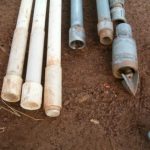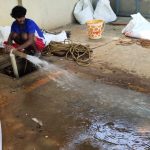Procedure for conducting plumbing test in bore well
Introduction
To calculate the hydraulic properties of an aquifer, we must first pump water from a well, measure the rate of the Plumbing and drawdown rate in the bore well, and then insert these values into the proper formula. Evaluating aquifer parameters is also known as aquifer testing.
The best source of drinking water is frequently determined to be groundwater, whose supplies are raised to the surface by repairing or drilling new boreholes. Samy bore well company is one of the best bore well contractor in Chennai provides bore well drilling, cleaning and plumbing services. An efficient method of learning about the borehole’s effectiveness and excellent production yield is to conduct Plumbing experiments.
Samy Bore well is a well-known bore well company in Chennai that offers bore well plumbing services for your needs.
Plumbing test
A Plumbing test involves plumbing groundwater from a well, often at a steady pace, and measuring water levels before and after Plumbing in the pumped well and any surrounding observation wells or surface water bodies.
A well’s performance, yield, zone of impact, and aquifer characteristics, including the aquifer’s capacity to store and convey water, its extent, the presence of boundary conditions, and potential hydraulic connections to surface water, can all be accurately estimated via a Plumbing test.
Plumbing test alternative names are aquifer test and aquifer performance test (APT). A Plumbing test is sometimes called a drawdown test in petroleum engineering.
The goal of performing aquifer tests is
In hydrogeological research, aquifer parameters are determined by performing Plumbing tests on dug, bore, and tube wells and analyzing the results.
In general, Plumbing tests are carried out for a variety of purposes, including the following:
a) To establish a borehole’s trustworthy long-term yield (also known as “safe” yield).
b) To evaluate the yield-drawdown characteristics of a borehole’s hydraulic performance. How much drawdown is required to produce a specific volume of water?
c) To determine the aquifer’s hydraulic characteristics.
d) The traditional (and possibly the only) method for determining in situ aquifer hydraulic properties, such as transmissivity and the storage coefficient, or for identifying any hydraulic boundaries, is to conduct Plumbing tests.
e) To evaluate the Plumbing and monitoring system’s performance,
f) To assess the impact of the abstraction on nearby abstractions (sometimes referred to as derogation).
g) To assess how the abstraction will affect the environment.
h) To offer details regarding water quality. Does the water’s quality permit its intended use? Are there likely any issues like bringing in saline or contaminated water after prolonged Plumbing?
I) To improve operational Plumbing schedules.
j) To determine the proper borehole depth at which we should put the permanent pump.
Typical Plumbing test types
The following are some examples of the typical Plumbing tests performed:
Constant-rate tests
In this test, the control well must continue to pump at a steady rate. The Plumbing test technique is most frequently used to estimate aquifer parameters. These tests, intended to offer information on the aquifer’s hydraulic properties, are conducted by Plumbing at a constant rate for much longer than the step test. We can only determine the aquifer storage coefficient if data from appropriate observation boreholes are available.
Step-drawdown tests
These tests are conducted at the control well using a series of constant-rate steps to identify well performance traits like well loss and well efficiency. Step tests are made to determine how quickly yield and drawdown change for the borehole under test. It involves Plumbing the borehole in several stages, each at a different discharge rate, typically with the rate rising with each step. The final stage needs to be close to the predicted borehole maximum output.
Recovery tests
These tests rely on measurements of the water level (residual drawdown) following the end of Plumbing.
A recovery test is an essential component of every Plumbing test, although being frequently interpreted individually.
After a constant-rate test, recovery tests are conducted by observing the recovery of water levels (and sometimes after a step test). It serves as a helpful check on the aquifer properties identified by the other tests, but it is only valid if a foot valve is installed on the rising main; otherwise, water surges back into the borehole.
Conclusion
Our customers can obtain best Bore well plumbing Services in Chennai from us. We guarantee our clients that we will finish the project on schedule. Additionally, we provide this top-notch service at incredibly competitive bore well cost in Chennai.





